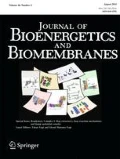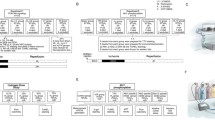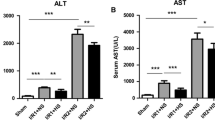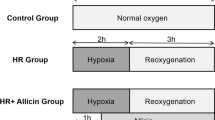Abstract
The effects of hydrogen-rich water on oxidative stress via the Nrf2/ARE signaling pathway were studied in rats with myocardial ischemia-reperfusion injury (MIRI). Sixty rats were randomly divided into a hydrogen-rich water group and a control group, with 30 rats in each group. The two groups were randomly divided into three groups: pre-ischemic period, ischemic period and reperfusion period. After the heart was removed, it was fixed in a Langendorff device and perfused with an oxygen-balanced 37 °C perfusate. The control group was perfused with Kreb’s-Ringers (K-R) solution, and the hydrogen-rich water group was perfused with K-R solution + hydrogen-rich water. The levels of mRNA and protein of Nrf2, NQO1, HO-1 and SOD-1 in cardiomyocytes were detected by RT-qPCR, immunohistochemistry (IHC) and Western blot analysis. SOD activity and MDA content were determined. Hydrogen-rich water increased the activation of the Nrf2/ARE signaling pathway, and the levels of mRNA and protein Nrf2, NQO1, HO-1 and SOD-1 were significantly increased (P < 0.05) in the ischemia-reperfusion period compared with the ischemic period. In the control group, the levels of mRNA and protein of Nrf2, NQO1, HO-1 and SOD-1 were significantly decreased (P < 0.05) in the ischemia-reperfusion period compared with the ischemic period. Compared with the ischemic period, the ischemia-reperfusion phase showed significantly increased SOD activity and significantly decreased MDA content in the hydrogen-rich water group, while SOD activity was significantly decreased, and MDA content was significantly increased in the control group (P < 0.05). Hydrogen-rich water can activate the Nrf2/ARE signaling pathway, alleviate ischemia-reperfusion injury in isolated rat hearts and reduce the oxidative stress level of myocardial tissue.






Similar content being viewed by others
Data availability
All data generated or analyzed during the present study are included in this published article.
References
Bao L, Li J, Zha D, Zhang L, Gao P, Yao T, Wu X (2018) Chlorogenic acid prevents diabetic nephropathy by inhibiting oxidative stress and inflammation through modulation of the Nrf2/HO-1 and NF-kB pathways. Int Immunopharmacol 54:245–253
Bawaskar HS et al (2019) Preintensive care: thrombolytic (streptokinase or tenecteplase) in ST elevated acute myocardial infarction at peripheral hospital. J Family Med Prim Care 8(1):62–71
Binder A, Ali A, Chawla R, Aziz HA, Abbate A, Jovin IS (2015) Myocardial protection from ischemia-reperfusion injury post coronary revascularization. Expert Rev Cardiovasc Ther 13(9):1045–1057
Cadenas S (2018) ROS and redox signaling in myocardial ischemia-reperfusion injury and cardioprotection. Free Radic Biol Med 117:76–89
Cao B et al (2018) Remote ischemic postconditioning (RIPC) of the upper arm results in protection from cardiac ischemia-reperfusion injury following primary percutaneous coronary intervention (PCI) for acute ST-segment elevation myocardial infarction (STEMI). Med Sci Monit 24:1017–1026
Chen H, Sun YP, Li Y, Liu WW, Xiang HG, Fan LY, Sun Q, Xu XY, Cai JM, Ruan CP, Su N, Yan RL, Sun XJ, Wang Q (2010) Hydrogen-rich saline ameliorates the severity of l-arginine-induced acute pancreatitis in rats. Biochem Biophys Res Commun 393(2):308–313
Chouchani ET, Pell VR, Gaude E, Aksentijević D, Sundier SY, Robb EL, Logan A, Nadtochiy SM, Ord ENJ, Smith AC, Eyassu F, Shirley R, Hu CH, Dare AJ, James AM, Rogatti S, Hartley RC, Eaton S, Costa ASH, Brookes PS, Davidson SM, Duchen MR, Saeb-Parsy K, Shattock MJ, Robinson AJ, Work LM, Frezza C, Krieg T, Murphy MP (2014) Ischaemic accumulation of succinate controls reperfusion injury through mitochondrial ROS. Nature 515(7527):431–435
Ding J, Yang Z, Ma H, Zhang H (2019) Mitochondrial aldehyde dehydrogenase in myocardial ischemic and ischemia-reperfusion injury. Adv Exp Med Biol 1193:107–120
Du H et al (2016) Hydrogen-rich saline attenuates acute kidney injury after liver transplantation via activating p53-mediated autophagy. Transplantation 100(3):563–570
Feng S, Xu Z, Wang F, Yang T, Liu W, Deng Y, Xu B (2017) Sulforaphane prevents methylmercury-induced oxidative damage and excitotoxicity through activation of the Nrf2-ARE pathway. Mol Neurobiol 54(1):375–391
Frassdorf J et al (2009) Anaesthesia and myocardial ischaemia/reperfusion injury. Br J Anaesth 103(1):89–98
Gao S, Zhang P, Zhang C, Bao F, Li H, Chen L (2018) Meroterpenoids from Ganoderma sinense protect hepatocytes and cardiomyocytes from oxidative stress induced injuries. Fitoterapia 131:73–79
Guo SX et al (2015) Effects of hydrogen-rich saline on early acute kidney injury in severely burned rats by suppressing oxidative stress induced apoptosis and inflammation. J Transl Med 13:183
Hayashida K et al (2008) Inhalation of hydrogen gas reduces infarct size in the rat model of myocardial ischemia-reperfusion injury. Biochem Biophys Res Commun 373(1):30–35
Jensen RV et al (2019) The role of O-GlcNAcylation for protection against ischemia-reperfusion injury. Int J Mol Sci 20(2):E404
Jia R et al (2019) Anti-oxidative, anti-inflammatory and hepatoprotective effects of Radix Bupleuri extract against oxidative damage in tilapia (Oreochromis niloticus) via Nrf2 and TLRs signaling pathway. Fish Shellfish Immunol 93:395–405
Jiang M et al (2019) Astragaloside IV attenuates myocardial ischemia-reperfusion injury from oxidative stress by regulating succinate, lysophospholipid metabolism, and ROS scavenging system. Oxidative Med Cell Longev 2019:9137654
Kang KM, Kang YN, Choi IB, Gu Y, Kawamura T, Toyoda Y, Nakao A (2011) Effects of drinking hydrogen-rich water on the quality of life of patients treated with radiotherapy for liver tumors. Med Gas Res 1(1):11
Li Q et al (2016) Neuroprotective effect of hydrogen-rich saline in global cerebral ischemia/reperfusion rats: up-regulated Tregs and down-regulated miR-21, miR-210 and NF-kappaB expression. Neurochem Res 41(10):2655–2665
Li X, Li L, Liu X, Wu J, Sun X, Li Z, Geng YJ, Liu F, Zhou Y (2019) Attenuation of cardiac ischaemia-reperfusion injury by treatment with hydrogen-rich water. Curr Mol Med 19(4):294–302
Loboda A et al (2016) Role of Nrf2/HO-1 system in development, oxidative stress response and diseases: an evolutionarily conserved mechanism. Cell Mol Life Sci 73(17):3221–3247
Nakao A et al (2010) Effectiveness of hydrogen rich water on antioxidant status of subjects with potential metabolic syndrome-an open label pilot study. J Clin Biochem Nutr 46(2):140–149
Ohsawa I, Ishikawa M, Takahashi K, Watanabe M, Nishimaki K, Yamagata K, Katsura K, Katayama Y, Asoh S, Ohta S (2007) Hydrogen acts as a therapeutic antioxidant by selectively reducing cytotoxic oxygen radicals. Nat Med 13(6):688–694
Parashar A, Agarwal S, Krishnaswamy A, Sud K, Poddar KL, Bassi M, Ellis S, Tuzcu EM, Menon V, Kapadia SR (2016) Percutaneous intervention for myocardial infarction after noncardiac surgery: patient characteristics and outcomes. J Am Coll Cardiol 68(4):329–338
Patwardhan J, Bhatt P (2016) Flavonoids derived from Abelmoschus esculentus attenuates UV-B induced cell damage in human dermal fibroblasts through Nrf2-ARE pathway. Pharmacogn Mag 12(Suppl 2):S129–S138
Prompunt E, Sanit J, Barrère-Lemaire S, Nargeot J, Noordali H, Madhani M, Kumphune S (2018) The cardioprotective effects of secretory leukocyte protease inhibitor against myocardial ischemia/reperfusion injury. Exp Ther Med 15(6):5231–5242
Ren C, Qi J, Li W, Zhang J (2016) The effect of moderate-intensity exercise on the expression of HO-1 mRNA and activity of HO in cardiac and vascular smooth muscle of spontaneously hypertensive rats. Can J Physiol Pharmacol 94(4):448–454
Rossello X et al (2019) Pathophysiology and therapy of myocardial ischaemia/reperfusion syndrome. Eur Heart J Acute Cardiovasc Care 8(5):443–456. https://doi.org/10.1177/2048872619845283
Shen NY, Bi JB, Zhang JY, Zhang SM, Gu JX, Qu K, Liu C (2017) Hydrogen-rich water protects against inflammatory bowel disease in mice by inhibiting endoplasmic reticulum stress and promoting heme oxygenase-1 expression. World J Gastroenterol 23(8):1375–1386
Steffens S, Montecucco F, Mach F (2009) The inflammatory response as a target to reduce myocardial ischaemia and reperfusion injury. Thromb Haemost 102(2):240–247
Steppan J, Berkowitz DE, Nyhan D (2018) Ischemic postconditioning and milrinone. J Cardiothorac Vasc Anesth 32(5):2149–2151
Takahashi M, Chen-Yoshikawa TF, Saito M, Tanaka S, Miyamoto E, Ohata K, Kondo T, Motoyama H, Hijiya K, Aoyama A, Date H (2017) Immersing lungs in hydrogen-rich saline attenuates lung ischaemia-reperfusion injury. Eur J Cardiothorac Surg 51(3):442–448
Uto K, Sakamoto S, Que W, Shimata K, Hashimoto S, Sakisaka M, Narita Y, Yoshii D, Zhong L, Komohara Y, Li XK, Inomata Y, Hibi T (2019) Hydrogen-rich solution attenuates cold ischemia-reperfusion injury in rat liver transplantation. BMC Gastroenterol 19(1):25
Wu MJ, Chen M, Sang S, Hou LL, Tian ML, Li K, Lv FQ (2017) Protective effects of hydrogen rich water on the intestinal ischemia/reperfusion injury due to intestinal intussusception in a rat model. Med Gas Res 7(2):101–106
Yang S, Chou G, Li Q (2018) Cardioprotective role of azafrin in against myocardial injury in rats via activation of the Nrf2-ARE pathway. Phytomedicine 47:12–22
Yellon DM, Hausenloy DJ (2007) Myocardial reperfusion injury. N Engl J Med 357(11):1121–1135
Yoritaka A et al (2016) A randomized double-blind multi-center trial of hydrogen water for Parkinson’s disease: protocol and baseline characteristics. BMC Neurol 16:66
Zhai X et al (2017) Hydrogen-rich saline improves nonalcoholic fatty liver disease by alleviating oxidative stress and activating hepatic PPARalpha and PPARgamma. Mol Med Rep 15(3):1305–1312
Zhang X et al (2018) Subcutaneous injection of hydrogen gas is a novel effective treatment for type 2 diabetes. J Diabetes Investig 9(1):83–90
Zhang CY, Ren XM, Li HB, Wei W, Wang KX, Li YM, Hu JL, Li X (2019) Simvastatin alleviates inflammation and oxidative stress in rats with cerebral hemorrhage through Nrf2-ARE signaling pathway. Eur Rev Med Pharmacol Sci 23(14):6321–6329
Zhou L, Wang X, Xue W, Xie K, Huang Y, Chen H, Gong G, Zeng Y (2013) Beneficial effects of hydrogen-rich saline against spinal cord ischemia-reperfusion injury in rabbits. Brain Res 1517:150–160
Zhou H et al (2017) Mff-dependent mitochondrial fission contributes to the pathogenesis of cardiac microvasculature ischemia/reperfusion injury via induction of mROS-mediated cardiolipin oxidation and HK2/VDAC1 disassociation-involved mPTP opening. J Am Heart Assoc 6(3):e005328
Zhou P, Lin B, Wang P, Pan T, Wang S, Chen W, Cheng S, Liu S (2019) The healing effect of hydrogen-rich water on acute radiation-induced skin injury in rats. J Radiat Res 60(1):17–22
Acknowledgements
The authors are grateful for the help provided by the Affiliated Hospital of Hebei University of China. The authors are grateful for the experimental hydrogen-rich water provided by Mr. Zhilin Li from the College of Chemistry, Hebei University (patent number ZL102557227B).
Funding
This research was financially supported by the Medical Science Research Key Project Foundation of Hebei Province (No. 20130369).
Author information
Authors and Affiliations
Contributions
Liangtong Li, Tongtong Liu, Li Liu, Shaochun Li and Zhe Zhang performed the qRT-PCR, Western blot and immunohistochemical analyses. Liangtong Li and Tongtong Liu collected the data and performed the statistical analyses. Zhe Zhang and Ruisha Zhang participated in sample collection and in the detection of SOD activity and MDA content. Yujuan Zhou and Fulin Liu designed the study. Liangtong Li and Tongtong Liu wrote the manuscript. All authors read and approved the final manuscript.
Corresponding authors
Ethics declarations
Ethics approval and consent to participate
The present study was performed at the Central Laboratory of Affiliated Hospital of Hebei University. All animal experiments were approved by the Animal Ethical and Welfare Committee of Hebei University (Baoding, China, approval no. 2017010) and performed in accordance with the Guidelines for the Care and Use of Laboratory Animals of Hebei University.
Patient consent for publication
Not applicable.
Conflict of interest
The authors declare that they have no competing interests.
Additional information
Publisher’s note
Springer Nature remains neutral with regard to jurisdictional claims in published maps and institutional affiliations.
Rights and permissions
About this article
Cite this article
Li, L., Liu, T., Liu, L. et al. Effect of hydrogen-rich water on the Nrf2/ARE signaling pathway in rats with myocardial ischemia-reperfusion injury. J Bioenerg Biomembr 51, 393–402 (2019). https://doi.org/10.1007/s10863-019-09814-7
Received:
Accepted:
Published:
Issue Date:
DOI: https://doi.org/10.1007/s10863-019-09814-7




